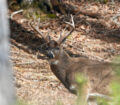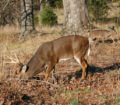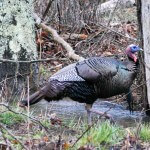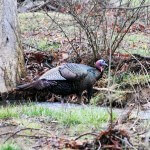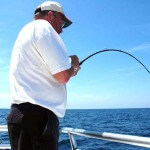Editor’s Note: If you put deer attractants along the edges of trails that deer use every day, they don’t have to find the attractants but will pass by them regularly. You’ll see more deer at your deer attractant sites next to trails, than if you just put an attractant out in the middle of the woods where there’s no deer sign at all.
 The swamp had flooded, and acorns were floating on the surface of the knee-deep water. From the numbers of cracked acorns on the bank, the hunter knew deer were feeding in this area, although he couldn’t find any tracks. He sat on the edge of the slough all day to see where the deer were moving and feeding. In the early morning light, he could hear acorns popping and water pouring as he made-out a dark figure in the 2-foot-deep water. Using his binoculars, he focused on the object and saw a fat doe knee-deep in the flooded timber, picking up acorns in her mouth, letting the water run out of her mouth, cracking the acorns and eating the meats of the nuts. In 2-1/2-hours, this hunter watched 15 other does moving along the edges or in the shallow water eating acorns. These deer were walking an underwater path that led through the flooded timber and their food.
The swamp had flooded, and acorns were floating on the surface of the knee-deep water. From the numbers of cracked acorns on the bank, the hunter knew deer were feeding in this area, although he couldn’t find any tracks. He sat on the edge of the slough all day to see where the deer were moving and feeding. In the early morning light, he could hear acorns popping and water pouring as he made-out a dark figure in the 2-foot-deep water. Using his binoculars, he focused on the object and saw a fat doe knee-deep in the flooded timber, picking up acorns in her mouth, letting the water run out of her mouth, cracking the acorns and eating the meats of the nuts. In 2-1/2-hours, this hunter watched 15 other does moving along the edges or in the shallow water eating acorns. These deer were walking an underwater path that led through the flooded timber and their food.
 In some states, shooting deer in the water is illegal. Even in the states where this type of hunting may be permitted, your chances of finding your deer may be better if you can pull the deer out of the water and make your shot while the deer’s on dry ground. By using an attractant, you often can pull the deer that are feeding on the acorns out of the water onto dry ground where you can take a shot. One of the major problems you may encounter, if you hunt along a flood plain, is that if your state prohibits the taking of deer in the water, and you know that in flooded timber the deer will be feeding out in the water on acorns that float to the surface, then to take a deer out of the water, you need to use a deer lure to attract the deer out of the water where you legally can shoot them. What makes this technique deadly effective is that the odor of the lure will waft out into the flooded timber and attract many-more deer than you can see. These deer will come through the water to reach your attractant.
In some states, shooting deer in the water is illegal. Even in the states where this type of hunting may be permitted, your chances of finding your deer may be better if you can pull the deer out of the water and make your shot while the deer’s on dry ground. By using an attractant, you often can pull the deer that are feeding on the acorns out of the water onto dry ground where you can take a shot. One of the major problems you may encounter, if you hunt along a flood plain, is that if your state prohibits the taking of deer in the water, and you know that in flooded timber the deer will be feeding out in the water on acorns that float to the surface, then to take a deer out of the water, you need to use a deer lure to attract the deer out of the water where you legally can shoot them. What makes this technique deadly effective is that the odor of the lure will waft out into the flooded timber and attract many-more deer than you can see. These deer will come through the water to reach your attractant.
 Once on another flood plain, a hunter located deer tracks going into the water just at dark. The next morning, he set-up a tree stand 20-yards from where he’d seen the tracks going into the backwoods beaver pond. As he watched, deer moved back and forth across the pond, apparently on an underwater ridge that was only 4- or 5-inches below the surface, yet wasn’t visible from the shore. Hunting this underwater ridge produced two fine bucks for him during that season. Each year since, when floodwaters have filled the backwoods, the hunter has bagged a deer there. Once again, the secret to taking deer that are crossing water is to decide which side of the water crossing you want to hunt. Put-out your deer attractant about 5 or 10 yards away from the trail the deer use to cross the water. You can take the deer before he gets into the water and not have to shoot the deer while it’s crossing or standing in the water. In the states that don’t permit hunting deer in the water, this is a very-effective way to be able to take deer that are crossing the water without violating the law.
Once on another flood plain, a hunter located deer tracks going into the water just at dark. The next morning, he set-up a tree stand 20-yards from where he’d seen the tracks going into the backwoods beaver pond. As he watched, deer moved back and forth across the pond, apparently on an underwater ridge that was only 4- or 5-inches below the surface, yet wasn’t visible from the shore. Hunting this underwater ridge produced two fine bucks for him during that season. Each year since, when floodwaters have filled the backwoods, the hunter has bagged a deer there. Once again, the secret to taking deer that are crossing water is to decide which side of the water crossing you want to hunt. Put-out your deer attractant about 5 or 10 yards away from the trail the deer use to cross the water. You can take the deer before he gets into the water and not have to shoot the deer while it’s crossing or standing in the water. In the states that don’t permit hunting deer in the water, this is a very-effective way to be able to take deer that are crossing the water without violating the law.

 To learn more about deer hunting, go to John E. Phillips’ books and learn the tactics small property owners have used successfully by checking out John E. Phillips’s book, “How to Hunt and Take Big Buck Deer on Small Properties” at https://www.amazon.com/dp/B00OOC2T0Y#, available in Kindle, print and Audible versions. To receive your free book on “How to Make Venison Jerky,” go to https://www.emailmeform.com/builder/form/Ece3UZVcOo52cKPJcL.
To learn more about deer hunting, go to John E. Phillips’ books and learn the tactics small property owners have used successfully by checking out John E. Phillips’s book, “How to Hunt and Take Big Buck Deer on Small Properties” at https://www.amazon.com/dp/B00OOC2T0Y#, available in Kindle, print and Audible versions. To receive your free book on “How to Make Venison Jerky,” go to https://www.emailmeform.com/builder/form/Ece3UZVcOo52cKPJcL.

